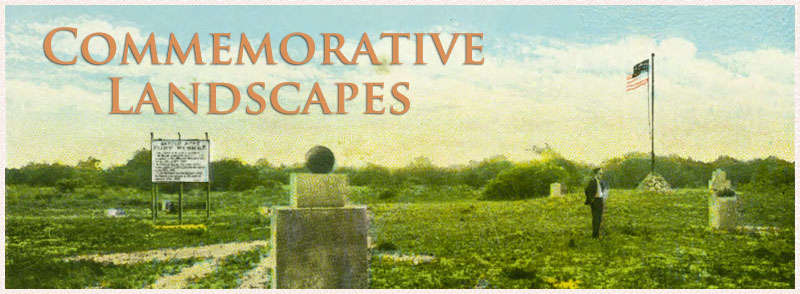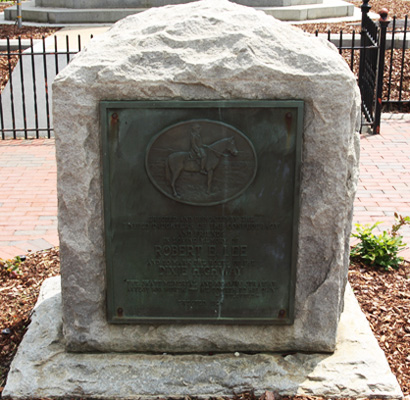
Robert E. Lee Dixie Highway, Colonel John Connally Marker, Asheville
The memorial is comprised of a rectangular bronze plaque attached to a roughhewn granite
block on a single roughhewn base. In relief inside an oval that encompasses one third of the
plaque is a representation of General Robert E. Lee astride his horse Traveller. The inscription,
also in relief, appears below the oval. The Asheville marker was the first of at least six with this
plaque placed in North Carolina.
In addition to the Dixie Highway plaque this marker also has a memorial plaque to Confederate
Colonel John K. Connally on the rear. Connally commanded the 55th NC regiment, one of several
regiments that lay claim as having gone “Farthest at Gettysburg.”
Images:
Rear plaque |
The marker was removed on July 10, 2020 by a joint resolution of the Buncombe County Board of Commissioners and the Asheville City Council |
Removed marker in front of the Zebulon Vance Monument
|
Where the marker stood
Front: ERECTED AND DEDICATED BY THE / UNITED DAUGHTERS OF THE CONFEDERACY / AND
FRIENDS / IN LOVING MEMORY OF / ROBERT E. LEE / AND TO MARK THE ROUTE OF / THE DIXIE
HIGHWAY / “THE SHAFT MEMORIAL AND HIGHWAY STRAIGHT / ATTEST HIS WORTH - HE
COMETH TO HIS OWN” / - LITTLEFIELD - / ERECTED 1926
Rear: IN MEMORY OF / COLONEL JOHN KERR CONNALLY / COMMANDING OFFICER OF THE
CELEBRATED 55 TH N.C. REGIMENT C.S.A. / WOUNDED AT GETTYSBURG 1863
City of Asheville
May 2, 1926
35.594980 , -82.551460
View in Geobrowse
Confederate Veteran, 34, (1926), p.161 (cover) 205, 237 Link
Bush, Matt. “Vance Monument Fully Shrouded, Lee Marker Removed,” WFAE.org, (Charlotte, NC), July 10, 2020, (accessed July 15, 2020) Link
Butler, Douglas J. Civil War Monuments, An Illustrated History (Jefferson, NC: McFarland & Company, Inc., 2013), 193
Hunt, Max. "Debate over Asheville’s Confederate Memorials Continues," MountainExpress (Asheville, NC), mountainx.com, July 6, 2017, (accessed August 30, 2017) Link
Walter, Rebecca. “Monumental Decision: Buncombe County Approves Removal of Confederate Statues,” Asheville Citizen Times (Asheville, NC), June 17, 2020, (accessed July 17, 2020) Link
Wicker, Mackenzie. “Confederate Monument Removed from Buncombe Courthouse Property,” Asheville Citizen Times (Asheville, NC), July 14, 2020
Yes
Bronze, granite
Plaque: United Daughters of the Confederacy, North Carolina Division. Granite block: Provided by the family of Colonel John Connally.
Mrs. James Madison Gudger, Jr., chair of the Dixie Highway Committee for the U.D.C. in North Carolina, unveiled the marker. During comments, Mrs. Gudger spoke of the “far reaching results” achieved in honoring the “memory of the South’s greatest hero, Robert E. Lee” and that the plaques will speak a “silent message through all the coming years.” She further said the markers will help “keep alive Southern traditions, and perpetuate…the true history of the Southland. At the completion of this dedication Mrs. Gudger and others traveled to Fletcher to dedicate an identical marker placed at Calvary Episcopal Church. An address on Robert E. Lee was given by Lucian Lamar Knight, state historian of Georgia at both dedications.
The Dixie Highway was first planned in 1914 and became part of the National Auto Trail system
and initially was intended to connect the Midwest with the South. Rather than a single highway
the result was more a small network of interconnected paved roads. It was constructed and
expanded from 1915 to 1927. The eastern route of the Dixie Highway mostly became U.S.
Highway 25. Starting in the late 1920s, the United Daughters of the Confederacy placed bronze
plaques on granite pillars to mark the route of the Dixie Highway and honor General Robert E.
Lee. Surviving examples in North Carolina can be found in Marshall and Hot Springs in Madison
County, in Asheville in Buncombe County and in Fletcher, Hendersonville and near Tuxedo all in
Henderson County.
The efforts to mark the Dixie Highway in North Carolina were led by Mrs. James Madison
Gudger, Jr. of Asheville who also designed the plaque. The North Carolina Division of the United
Daughters of the Confederacy raised $800 to have the die cast for the plaque and then loan it
to other states for marking their highways. Other states do not appear to have taken advantage
of the die aside from an example in Greenville, South Carolina. It is thought that 10 total were
made from this die leaving several unaccounted for.
Following the massacre of nine African Americans in a church in Charleston, South Carolina on June 17, 2015 by white supremacist Dylann Roof, Americans, especially southerners, have reflected on and argued over the historical legacy of slavery, the Civil War, the Confederacy, and white supremacy. Monuments have been a particular focus of these debates and controversies, especially after the death of a counter-protester, Heather Heyer, at a white supremacist rally in Charlottesville, Virginia in August 2017 and after President Donald Trump expressed his opposition to the removal of Confederate memorials. Despite laws in many southern states intended to prevent or impede the removal or relocation of historical monuments, protesters and local community leaders have removed or relocated controversial monuments associated with slavery, the Confederacy, and white supremacy. The pace of the removal of controversial monuments accelerated sharply in 2020, following the death of George Floyd at the hands of police in Minneapolis, Minnesota. Against the backdrop of protests against police brutality and white supremacy across the nation, local authorities in many communities in North Carolina removed and/or relocated monuments that were the focus of civil unrest.
Buncombe County and the city of Asheville approved a joint resolution to remove Confederate monuments located at the Buncombe County Courthouse and Pack Square Park. The Buncombe County Board of Commissioners approved the resolution by a 4-3 vote on June 16, 2020. The Asheville City Council had approved the resolution by a 7-0 vote on June 9, 2020. The monument to the 60th NC Volunteer Regiment and a Robert E Lee Dixie Highway/Colonel John Connally marker were deemed to be the property of the United Daughters of the Confederacy (UDC). The UDC was given 30 days to respond and then 90 days to remove the memorials. Al Whitesides, the only African American on the County Board of Commissioners spoke for several minutes. “I’m voting for all my ancestors that died to make this country the great country it is today,” he said. After receiving no response from the UDC the city and county acted to remove the monuments. The Robert E Lee Dixie Highway/Colonel John Connally marker was removed from Pack Square Park on July 10, 2020 at an approximate cost of $1,100. The monument to the 60th NC Volunteer Regiment was removed from Buncombe County Courthouse grounds on July 14, 2020. A 12 person task force was to be formed to determine how to repurpose or legally remove the Zebulon Vance Monument also located at Pack Square Park as its ownership was unclear. The resolution to remove the monuments also called for the Vance monument to be completely shrouded until its fate was determined. That task was completed on July 10 with cost of the shrouding alone estimated at $18,500.
The marker was removed by city of Asheville contractors on July 10, 2020 and placed in storage at an undisclosed location. The marker stood near the center of Pack Square Park right in front of the Zebulon Vance Monument. Several hundred yards east in the immediate area of the old Buncombe County Courthouse there are other notable plaques, monuments and memorials: Western North Carolina Veterans Memorial, 60th NC Regiment, Revolutionary War, Spanish American and other wars, Police and Firemen who died in the line of duty, Medal of Honor recipient Lt. Colonel Robert Morgan and former Governor Samuel Ashe for whom Asheville was named.
The marker stood in the center of the downtown square, surrounded by beds containing seasonal plantings.
The monument stood in Pack Square Park near the Zebulon Vance monument in downtown Asheville until its removal on July 10, 2020.
 Know anything else about this monument that isn't mentioned here? If you have additional information on
this or any other monument in our collection fill out the form at the Contact Us link in the footer. Thank you.
Know anything else about this monument that isn't mentioned here? If you have additional information on
this or any other monument in our collection fill out the form at the Contact Us link in the footer. Thank you.

